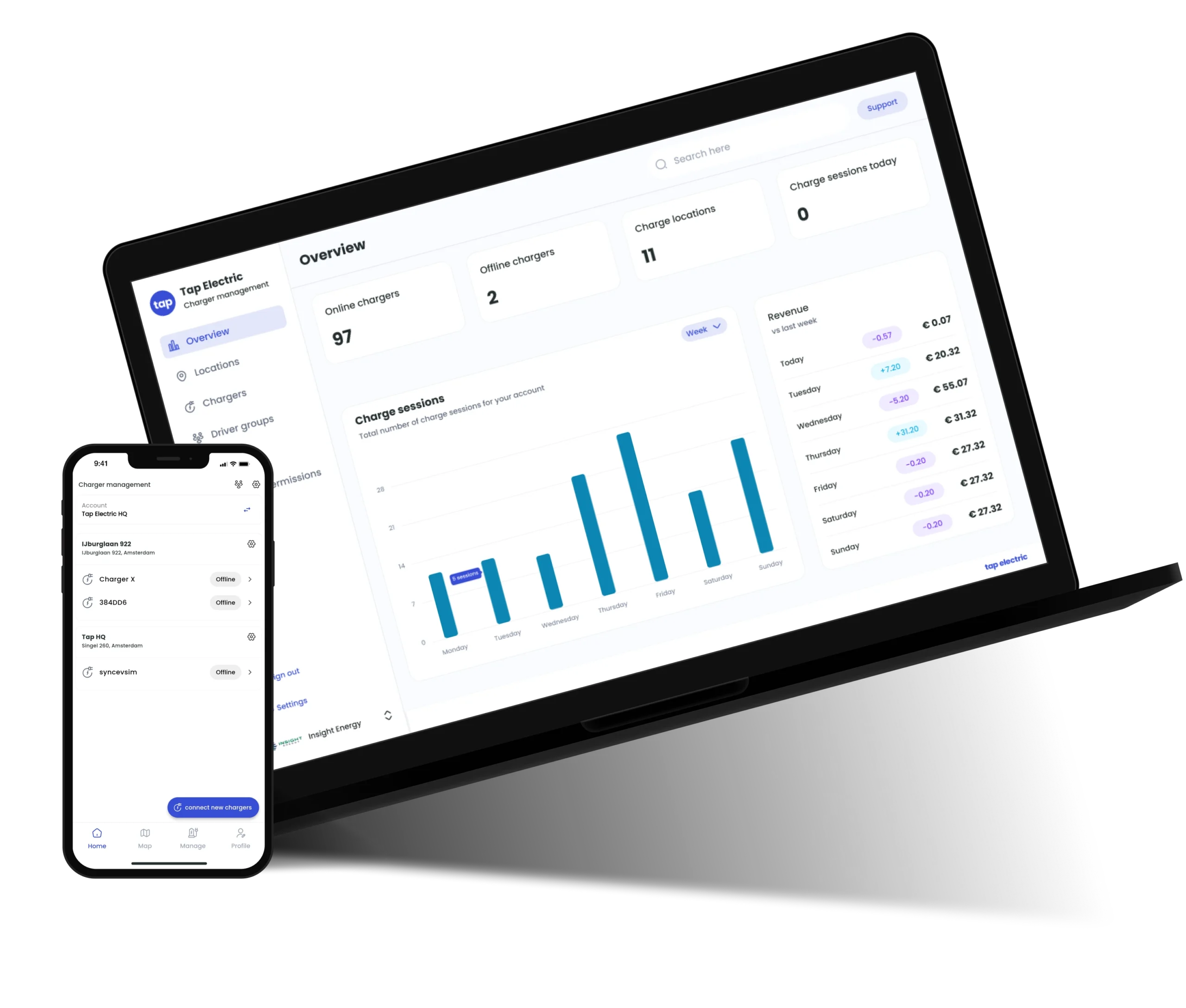IMPORTANT CHANGES:
May 2025: Streamlining installation with new Permitted Development Rights (PDR)
Effective May 29, 2025, the UK Government introduced pivotal changes to the Permitted Development Rights (PDR) for EV charge points. These reforms significantly cut red tape, meaning drivers, homeowners, and businesses generally no longer need to submit planning applications to install EV charge points at home, workplaces, and public spaces across England. This makes the process easier, quicker, and cheaper and aims to accelerate the rollout of EV charging infrasture nationwide.
November 2024: Enhancing the driver Experience with Contactless Payments
From November 24, 2024, UK regulations mandate that all new public charge points with a power rating of 8kW and above, and all public charge points of 50kW and above (regardless of installation date), must offer contactless payment options either per chargepoint or per charging site.
Tap is your free charger management platform with built-in compliance features to help charger owners and installers stay on top of all UK regulations.
Payments via Contactless & Roaming partners
Key takeaway: Contactless payment must be available at all new public charging stations 8kW and above installed after 24 November 2024 and at all public charging stations of 50kW and above by 24 November 2024.
In more details
- Public charge points which are available to the public free of charge are out of scope of this requirement.
- Where the regulations refer to a power rating, for example 8kW, this refers to the power that can be delivered per cable and is not aggregated to the charge point level.
Contactless:
Proprietary charge point networks which subsequently open for public use have one year to offer contactless.
The contactless payment may accept payment such as Apple and Google Pay but must also accept contactless bank cards.
A public charge point may offer contactless alongside additional payment methods, such as an app or QR code.
Roaming:
- Roaming is the ability to pay to charge an EV across multiple charge point networks using a single app or RFID card. The equivalent for petrol and diesel vehicles is a fuel card.
- Charge point operators must offer roaming at all their public charge points by connecting to at least one third party roaming provider.
- Charge point operators may choose to connect with third party roaming providers for example, through direct partnerships with other charge point operators, connecting to a clearing house or through an e-mobility service provider (eMSP).
- The roaming provider must be operated by a person or organisation that is external to the charge point operator.
How Tap facilitates contactless payments:
- Tap partners with Payter, a leader in contactless payment terminals for EV chargers. Easily onboard Payter terminals and collect payments, all via the Tap platform.
Reliability and uptime
Key takeaway: Charge point operators must ensure they meet the reliability requirement, which requires their rapid public charge points to be available 99% of the time. This will be measured as an average (mean) across a charge point operator’s rapid network of public charge points of 50kW and above over the calendar year.
In more details
- A charge point operator will not be penalised if their reliability is below 99% for a given month, as long as they make this up over the rest of the 12-month period, so that their reliability remains at 99% or above for the whole year.
- Reliability will be measured through electric vehicle supply equipment (EVSE) object statuses using the Open Charge Point Interface protocol (OCPI).
- Payment terminals and charging stations that are in locations with restricted hours are also applicable to these regulations. In addition, charge point operators must publish information on their compliance with the reliability requirement on their website.
How Tap helps with your charger reliability:
- Manage and troubleshoot your chargers remotely at scale with Tap’s free charger management platform via our web portal or on the go with the app.
- Using OCPP, you can identify and diagnose issues with your hardware or internet connection. Reliable, quality hardware and a stable internet connection is key to providing high uptime and a good charging experience for drivers.
24/7 Helpline & Support
Key takeaway: A charge point operator must provide a free to use, staffed telephone helpline that is available 24 hours a day, 365 days a year for consumers. The contact details for the helpline must be displayed prominently on or at the charging site for all public charge points they are responsible for.
In more details
- The helpline must be free to use. Numbers that charge local call rates will not fulfill this requirement.
- Charge point operators are expected to support consumers and resolve issues that are within their control, such as software issues. Charge point operators are not expected to resolve issues over which they have no control, such as power outages.
- The deadline for this support number to be set up and available for public use is December 2024 with further reports in January 2025, April 2025 and quarterly thereafter.
How Tap can help support you and your drivers:
- Get 24/7 expert support for your EV charging needs with Tap. We’re here to help installers, owners, operators, and drivers with any questions or issues, completely free of charge.
Pricing Transparency
Key takeaway: A charge point operator must ensure that the maximum price that a consumer could be charged during their charging session, is clearly displayed in pence per kilowatt hour (p/kWh) or pounds per kilowatt hour (£/kWh) on the public charge point or through a separate device.
In more details
Fixed charging fees, including connection fees, transaction fees and any other category of fees, must be included in the maximum price displayed to consumers in the p/kWh format.
This does not apply to separate fixed fees that a third party may charge the consumer for parking at the charge point location.
For subscription pricing models, the price that the consumer will be charged for their charging session based on their subscription should be displayed in p/kWh on the charge point or through a separate device.
Where the subscription provides a limited amount of charging at a reduced rate, the charge point operator should also set out the remaining allowance that the consumer has left at this price and the price in p/kWh that the customer will be charged after this point. The maximum price for non-subscription customers should also be clearly displayed in p/kWh.
How Tap helps you make your chargers transparent:
You set your charger prices. On top of this price, we add a small service fee for drivers when they use your charger. We’re transparent about our pricing structure to all customers and we believe this model keeps charging affordable for everyone.
All charger prices are clearly shown to drivers in the Tap app. This includes any price / kW, hourly price, idle price and starting fee. This price reflects any driver subscription discount and includes VAT.
During a charge session, drivers can track their energy consumption, power and cost in real-time.
Open data
Key takeaway: Charge point operators must hold all data about their public charge points accurately and in accordance with the data requirement and ensure that the required data is opened from 24 November 2024.
In more details
- The regulations require that charge point operators make available reference data and availability data for each electric vehicle supply equipment (EVSE).
- Reference data means information that does not change frequently about a charge point including but not limited to location, connector type, pricing, payment method and time restrictions.
- All data must be made publicly available free-of-charge and in a machine-readable format. Data in a machine-readable format can be automatically read and processed by a computer system.
- To achieve this, charge point operators must ensure that the required data can be communicated to anyone who wishes to receive it. The most widely used method for enabling the communication of large amounts of machine-readable data is an application programming interface (API).
Further details on the required data types are listed on the UK Government website.
How Tap helps with open data compliance:
- Easily export location and charger information, as well as how your chargers are being used from our platform for your records in machine readable format.
Reporting deadlines
Key takeaway: There are reporting requirements across roaming, reliability, and helpline under these Public Charge Point Regulations.
In more details
- High level templates for each reporting requirement will be available before the regulations come into effect.
Further details on the reporting guidelines are outlined on the UK Government website.
How Tap can help with your charger reporting requirements:
- Get comprehensive, detailed reporting on how your chargers are being used at any time with our self-service platform.

Try the Tap app
Stay on top of
UK charger regulations
Get out-of-the-box compliance for all UK regulations with Tap.

Resources and expertise:
the methodology behind our data
Our experts fact checked and last updated this research on 18 June 2025.
Sources:
Regulations:
- Official UK Government website
Details:
Our experts created this guide for installers, owners and operators of EV charging infrastructure.